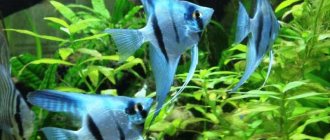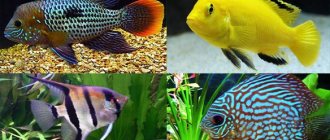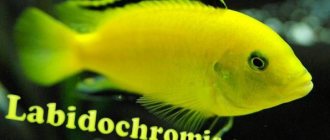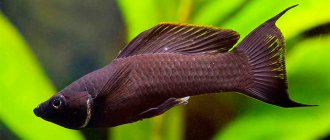Aquarium angelfish fish from the Cichlid family are charming inhabitants of artificial reservoirs, which are loved by aquarists not only for their external beauty and unpretentiousness. The main quality due to which angelfish have gained popularity is considered to be the fish’s ability to adapt to different living conditions and thrive in captivity for many years. However, aquarists interested in how long angelfish live in captivity should know that these fish are susceptible to many ailments. It is the diseases of the angelfish that cause the life of pets to suddenly end, so every holder of these fish should know the signs and methods of treating ailments.
Aquarium fish angelfish photo and description
Angelfish are the most common aquarium fish of the cichlid family, which are not only very beautiful, but also have unusual behavior that distinguishes them from others. There are three types of angelfish:
- The common angelfish has a classic body shape of a silvery color with four transverse stripes;
- Angelfish altum or tall-bodied, characterized by an elongated body - some grow up to 30 cm in height;
- Leopold's angelfish is a small species with an aggressive disposition.
- golden green, smoky, striped, black,
- two-color (bicolor);
- tricolor (Koi).
- lace;
- zebra;
- train or veil;
- black;
- gold;
- blue;
- marble;
- Red Devil;
- pearl or diamond;
- chocolate;
- white;
- Pinoy (Pinoy Zebra);
- Dantum Albino.
Aquarium fish Angelfish are not very whimsical, slow and graceful. They are very curious by nature and will watch with interest what is happening in the aquarium. They have a developed intellect and treat their offspring with care. If you walk into a room, they will certainly react to you.
Table of basic parameters of maintenance, care and nutrition:
| What should be the volume of an aquarium for Angelfish? | from 100 liters for a flock from 150 liters |
| What should be the temperature in the aquarium for Angelfish? | from +25-28° C |
| What pH should be in the aquarium? | from 5.5-7.5 pH |
| What should be the hardness of the water in the aquarium? | from 5-15° dH |
| What should be the substrate for an aquarium? | small pebbles or coarse sand suitable for living plantings |
| What kind of lighting should be in the aquarium? | moderate and daylight hours at least 12 hours |
| What should be the movement of water in the aquarium? | moderate |
| Maximum fish size | length up to 15 cm. Height from 26-30 cm (a lot depends on the volume of the aquarium) |
| What does aquarium fish eat? | almost any live food: bloodworms, adult brine shrimp, coretra, tubifex and specialized dry food |
| Type of aquarium fish | peaceful, but small fish and shrimp can become food for them |
| Who is compatible with in an aquarium? | compatible with all peaceful ones that do not fit in the mouth |
| Lifespan of an angelfish | in aquariums they live up to about 10 years, but with proper care up to 20 years |
Interesting Facts
There are quite a lot of freshwater fish with tall bodies, but angelfish are the only fish whose height exceeds their length. The shape, coloring, and slowness of the angel fish speak of a passive survival strategy. There is an assumption that, with its unusual features, the angelfish deceives its predatory counterparts. She seems to be saying, “I’m not a fish.” The angelfish genus has existed for millions of years, which means this survival strategy works.
Leopold's angelfish was kept in aquariums for 30 years before biologists took notice of it. Only in 1963 this species was included in the biological classifier. Biologists claim that not all species of angelfish have been discovered, described and included in the biological classifier. South American river basins are enormous water systems. It is possible that in these places there are unexplored tribes of people, let alone small fish.
How to care for Angelfish in an aquarium at home
Considering the size of this aquarium fish , to keep it you need to purchase a spacious aquarium - at least 100 liters, but if you keep a flock, then the aquarium should be 150 liters or more. It is necessary that there is enough space for free swimming.
Contents Angelfish cannot be called complex. Considering that these are tropical fish, you need to maintain a water temperature of 25-28° C. Optimal acidity is approximately 5.5-7.5 pH, hardness is 5-15° dH. They live only in aquariums with aeration and filtration. You also need to turn on the compressor twice a day for 20-30 minutes and change the settled water weekly, in a volume of 30%. They like moderate lighting, as they are shy when bright lights are turned on. Thickets of Vallisneria will create an imitation of the natural habitat. Angelfish do not need shelter.
Adviсe
Experienced aquarists advise when choosing an aquarium to give preference to high tanks (at least 45 centimeters in height). Considering that the body of these fish is more elongated vertically than horizontally, they will be more comfortable in high rather than low tanks.
When arranging an aquarium, attention should be paid to ensuring that the fish have the opportunity to move freely in space. For these purposes, it is recommended not to clutter the central part of the tank with decorative items.
When keeping angelfish, it is worth considering that sometimes these cute creatures may refuse to eat for no reason. Their period of “fasting” can take from several days to 2 weeks. This behavior, according to experienced aquarists, is normal for these fish.
Taking into account the fact that angelfish are divided into pairs during the mating season, they should initially be purchased in a flock containing an even number of individuals. This approach will ensure that not a single fish is left alone.
What to feed Angelfish
Angelfish do not require special nutrition. They perfectly consume almost any live food: bloodworms, adult brine shrimp, coretra, tubifex.
It is better to feed angelfish with frozen food, but the food must be brought to room temperature before feeding. Finely chopped ground beef or seafood, specialized dry food, which can be purchased at any pet store, are also suitable.
It is better to feed the fish 2-3 times a day little by little, while making sure that the food is eaten within 1-2 minutes, otherwise overfeeding may occur, which will worsen the health or even contribute to the death of the Angelfish. It is also useful to give your pets “fasting days” once a week - feed them only plant foods.
Feeding
What to feed? Angelfish are omnivores; they eat any type of food in an aquarium: live, frozen and artificial. The basis of feeding can be high-quality flakes, and additionally give live and frozen food: tubifex, bloodworms, brine shrimp, and coretra. It is important to know two things, they are gluttons and cannot be overfed, no matter how much they ask. And give bloodworms very carefully, and it is better to refuse it altogether. A slight overfeeding of bloodworms, and the angelfish begins to bloat, so much so that pink bubbles stick out from the anal bladder. It is much safer to feed with branded food, since it is now of high quality.
Angelfish can pick off tender plants, although not often. They regularly tear off the tops of my eleocharis and tear off the moss from the snags. In this case, you can add food with spriulina to the diet.
How to distinguish a male Angelfish from a female
It is sometimes difficult to distinguish the sex of a given fish and is only possible when they become sexually mature - at 8-12 months. When buying young animals, you clearly cannot distinguish a male from a female, but the larger ones will probably turn out to be males.
The main distinguishing feature is that males have a fatty bump on their forehead, while female Angelfish do not. Also, in pairs, males are more active, but this is not a clear distinguishing feature, because sometimes females also imitate the behavior of the male.
History of appearance
The first information about the fish can be found in 1823 in the work of the German scientist Schultz. It got its name thanks to the Australian zoologist Heckel in 1840. European residents were able to get acquainted with it only in 1920 and begin to successfully breed it at home; before that time, all imported representatives of the species died. The angelfish came to the United States in 1930.
Ferdinand Schulz described the angelfish in 1823 and gave it the name Zeus scalaris. The famous Austrian zoologist named it in 1840 - Pterophyllum, which means “winged leaf” from Latin. Georges Cuvier described and named the fish Platax sciaris in 1931.
It was possible to bring fish to Germany in 1911; before they died. In 1914, they were propagated artificially for the first time; details were not disclosed until 1920, then aquarium hobbyists began breeding angelfish everywhere. It came to the USA in 1930. In the second half of the 20th century, breeders developed many breeds of this species.
How do angelfish reproduce?
Angelfish form a monogamous pair and are faithful to their partner. They can spawn directly in the aquarium. When a pair of Angelfish plans to reproduce, they stay together, drive away other fish and clean the place they have chosen for spawning. They spawn every 7-10 weeks. In this case, the female lays several hundred eggs on leaves, pieces of driftwood, and even on the glass of the aquarium, after which the male fertilizes them. Next, larvae appear, which after some time become fry.
In addition to all their advantages, Angelfish are also caring parents who not only look after their eggs, but also the hatched fry.
Factors affecting fish life
Several factors, in addition to their health, influence the lifespan of angelfish in artificial conditions. Knowing what to do, you can extend the life of fish for as long as possible. For a high-quality and long life, angelfish must be provided with:
- the volume of the aquarium is 100 liters per fish - in a tighter reservoir, angelfish cannot develop normally and do not grow fully. Against the background of underdevelopment, internal organs fail within a short period of time after 2-4 years, and the fish dies. Intestinal problems, red eyes (not to be confused with red-eyed species) and lethargy are common, these are signs of a general disorder in the body;
- aeration – the fish’s need for oxygen is increased, so it is necessary to turn on the compressor in the aquarium for 30-40 minutes in the morning and evening. This improves the condition of pets and, by increasing immunity, prevents them from contracting bacterial infections. Treatment, if necessary, is faster and easier;
- cleaning the bottom - remove food residues, fish waste and rotting parts of plants once a week. When the aquarium is cloudy, the fish suffocate in it from poisoning by rotting products;
- water replacement - water should be replaced 1/4 times a week and 4/5 - 1 time every 3 months. The characteristics of fresh water must correspond to those remaining in the aquarium. When the water is different, angelfish experience severe stress, which is harmful to their health. It is not uncommon that if the change is incorrect, you can see that the angelfish’s eye has become cloudy;
- nutrition – it should be as close to natural as possible. Angelfish should be given bloodworms, coretra, daphnia, earthworms soaked in water, snails, and cyclops. Combined food and vegetable food are required: lettuce, woodlice, spinach, finely grated cucumber. Feed portions should be such that the fish eat them within 5-10 minutes. Any remaining food that has settled to the bottom is removed immediately. If fed incorrectly, the angelfish's intestines may protrude, the body may swell, and the belly may swell.
Compliance with maintenance rules ensures angelfish a long life. When populating a reservoir, it is necessary to ensure the following water parameters:
When starting an aquarium for the first time, steps must be followed so that the pets enter fully prepared water that will not settle in their presence. Without this, the fish become very white and if their fins and eyes turn red, treatment is difficult.
What fish get along with Angelfish in an aquarium?
Common angelfish are peaceful and calm, but due to their large size, it is undesirable to live next to small fish, which can become food for them. Angelfish get along well with a group of barbs, but if one or a couple of barbs are in the neighborhood, the Angelfish will probably have its fins bitten off.
All colorful peace-loving fish will be good neighbors - Gourami, Swordtails, Botia, catfish, Labeo and Tetras, pseudotropheus, Discus, Congo, erythrozonus. You cannot place bettas, Ternetius, Danios, and Guppies in the same aquarium of gold and fighting fish. Angelfish usually make good neighbors with fish of the same species.
Motherland
The natural habitat of these cichlids is the warm, slow-flowing waters of rivers, numerous tributaries of the Amazon and Orinoco, the channels of which mainly pass through the territories of Brazil and Venezuela.
The formation of a flat body, whose height is greater than its length, is due to the dense vegetation of natural reservoirs. Thickets are an integral part of the formed biosystem. It’s easy to hide among them. In addition to fry, small fish, invertebrates and insects, the diet of angelfish includes plants. Females lay eggs on the wide leaves of plants and raise their offspring.
The body structure of the angelfish is designed specifically for swimming in South American rivers.
The peculiar camouflage color with transverse dark lines on the silver body and paired stripes passing through the red eyes also helps protect against predators.
In the homeland of angelfish, the water of the largest South American rivers is characterized by weak acidity and medium hardness. Temperatures, depending on seasonality, range from 18–30°C. Decreases during tropical rainfall. In order for the fish to live comfortably, these parameters are observed when growing them or breeding them in a home pond.
What diseases does Angelfish have?
Like any living creature, Angelfish are susceptible to various diseases. If your pet has an inflamed anus, then most likely it is hexamitosis, which means that parasites have settled in the body. It is important to provide timely treatment and place the sick fish separately.
In cases of severe glucose disease, the fish exhibits bilateral bulging eyes and white spots and bumps on the body. The disease usually leads to death. The fish needs to be removed urgently and the aquarium needs to be completely cleaned.
When infected with a rod-shaped bacterium, Angelfish become passive, the ends of the fins and side “fins” rot, a white coating appears on the body - fin rot, and the eyes become cloudy. Immediate treatment is required.
Angelfish are also susceptible to infection with saprolegnia molds. In this case, it is important to start treatment immediately, otherwise, if the fungus penetrates the internal organs, unfortunately, it will not be possible to save the pet.
Compatibility
Voracious angelfish prey on fry, small fish (guppies, neons, cardinals), and shrimp, so keeping them together in a home pond is impossible. In turn, barbs, ternets, and tetragonopterus eat the fins of the “angels.” Pterophyllum is incompatible with cockerels and goldfish. Although there are exceptions to the rules.
Angelfish get along better with their neighbors if they are introduced to a stocked aquarium at a young age.
Suitable for living in a community aquarium with angelfish:
- tetras;
- gourami;
- Congo;
- mesonouts;
- swordtails;
- mollies;
- zebrafish;
- catfish.
Select neighbors for your aquarium based on the table to protect your pets.
The latter species gets along with any neighbors. The fact is that bottom fish do not interfere with others, occupying their niche in the reservoir. The only caveat is the need to purchase special food that quickly sinks to the ground, so that angelfish with a good appetite do not leave the catfish hungry.
To keep aquarium pets in peace and harmony with angelfish, ichthyologists recommend:
- raise different species together from an early age;
- provide underwater inhabitants with sufficient space in the reservoir so that there are no clashes over territory;
- Prefer calm, slow ones, similar to angelfish, to nimble species;
- identify and immediately place aggressive bullies in another aquarium;
- exclude the proximity of too small and large individuals.
Regardless of the size, behavioral factors and types of ornamental fish, aquarists should study the appropriate water parameters and care rules so that all inhabitants live comfortably.
Breeding forms
Aquarists create a colorful underwater world, distinguished by its individuality, populating the home pond with modern varieties of angelfish:
Blue Angel
A young breeding form with blue scales and translucent fins of the same color. The remains of dark transverse stripes are visible on the body. Representatives of the breed are valued higher if the color is intense and the dark vertical lines are invisible.
Diamond
In the light, the scales of the silver angelfish shine and shimmer like a cut diamond, hence the name. Transparent fins attract attention. Breeders use the breed to develop new varieties.
Golden
A distinctive feature of the species is golden areas of scales of different sizes on a large silver body without signs of dark stripes. The fins, shorter than those of other angelfish species, lack pigment.
Black or Ludwig's angelfish
The form was developed by selecting and crossing fish with dominant black stripes. Thoroughbred specimens are black, including fins. Silvery areas of scales are a reason for culling. The black subspecies is distinguished by its unpretentious maintenance and care.
Koi
Externally, the most attractive breed of angelfish is similar in color to the carp of the same name. The white body without stripes is painted with yellow, black, and orange spots.
Red and green types of fish require special care - they are given food with colored additives. The white angelfish differs from albinos in the absence of a red rim around the eyes. Rare, not fully studied species include pink fish that glow in the dark. Leopard and marbled angelfish are of interest, attracting attention with their unusual colors.
If you adhere to the rules for keeping and caring for cichlids and exclude stressful situations, observing the life of beautiful angelfish in a pond will last for many years. Aquarists involved in breeding are keen on selection, consolidating and improving species characteristics.
Even the simplest angelfish look great in an aquarium - either a species or a general one.











